Business To Business
-
- The Future Of E-Commerce: Will The Maritime Industry Be Left Behind? Maritime Reporter, Nov 2000 #12
Maritime business commerce has changed rapidly over the last decade. In order to stay competitive, companies are increasingly inventing more efficient ways to conduct business. The advent of the Internet has created new tools to negotiate and complete business transactions for all major industries. Electronic commerce ("e-commerce") in particular, is revolutionizing the way industries transact all business. The buzzwords of today's marketplace are speed, accuracy and efficiency. Businesses are turning to the Internet as an outlet to increase sales and market share. A successful transition from paper to electronic business, however, requires a well-established electronic and legal infrastructure in order to succeed.
The information technology industry is now challenged with the task of creating compatible electronic systems through which multinational parties may transact business more efficiently. The expansion of business-to-business ecommerce has also challenged the legal industry to create new legal assurances for parties involved in electronic transactions.
The transactions previously negotiated on paper and culminating in a signature and a handshake now require the guarantee of document authentication and party-identity validation. These challenges are being met with the creation of electronic security measures designed to protect the transaction.
So where does the maritime industry fit into this technological and legal transition?
Given the complexity of maritime transactions, the industry must establish its role during this transition and determine how best to proceed in today's electronic marketplace.
Technological Issues Related to Business-to-Business E-Commerce In order for business to be able to communicate electronically through an exchange of documentation, a need developed for an electronic system capable of paperless commerce. This need led to the creation of Electronic Data Interchange ("EDI"). EDI is the computer- to-computer exchange of specifically formatted messages creating commercial documentation. EDI converts information that would traditionally be transmitted in paper form to electronic messages. In order to benefit fully from the use of EDI, the contracting parties' electronic systems must be compatible and capable of directly communicating with all parties involved. Currently.
most systems capable of running EDI are mainframe computers and not desktops. Therefore, the two businesses involved in a transaction must have highly compatible mainframe systems capable of running EDI to ensure the required level of standardization. This required standardization naturally excludes smaller businesses with incompatible systems from the exchange of electronic documentation.
The maritime industry has not been a principle leader in EDI, however efforts have consistently been made over the years to transfer key documents electronically, such as the bills of lading.
SEADOCS was the first effort launched to create an electronic bill of lading system.
The venture eventually failed due to high-added transaction costs and confidentiality concerns from the maritime industry, since all trading information would be recorded and kept in a central location.
There currently exists no standard data form other than EDI in which the documents may be exchanged. The Comite Maritime International (CMI) has, however, created model rules for transmission of electronic bills of lading under EDI, which the parties to a transaction can adopt by agreement. Other industries have created standardized data exchange systems, which have been very successful. The SWIFT system (Society for Worldwide Interbank Financial Telecommunications), for example, established a standardized exchange for letters of credit communications between banks and beneficiaries.
The efficiency of document exchange via e-commerce for the maritime industry can only be increased if a better mode of online information exchange is created. Currently, standardization outside of the EDI realm is left to the individual parties.
Not only must the industry itself develop a standard data format, but also EDI in general will need to be modified in order to survive. Large multinational corporations have their own data systems in place through Internet websites and are dictating individual data exchange mechanisms with their customers and suppliers.
This type of competition with EDI should foster the proper environment necessary to create new and uniform data exchange systems capable of use and acceptance by companies at all levels of capitalization.
Legal Issues Related to Business-to-Business E-Commerce As with paper documentation, electronic contracting gives rise to legal rights and duties. Transitioning business-to-business commerce to e-commerce requires applying traditional procedures for creating binding agreements, establishing assured payment mechanisms and settling disputes to Internet transactions. Evidence of electronic transactions must be made sufficiently reliable to prove the making of and the contents of the contracts. The goal today is to put electronic transactions on the same legal level of acceptability and uniformity as paper transactions. In order to achieve this goal, three critical issues must be evaluated before transacting maritime business via e-commerce: security of the transaction, negotiability of the terms, and choice of governing law.
Business-to-business e-commerce raises multiple security issues for the maritime industry. For example, how will parties ensure that the bill of lading or purchase order has not been tampered with during transmission from the buyer to the seller?
Authentication and validation of electronic documentation is a major concern for any industry conducting business over the Internet. With EDI, the parties only have the transmitted document from the transferor without any assurance as to authenticity or lack of alteration. The advent of digital signatures, with the use of public and private keys, to pass secure messages through a trusted third party, or certification authority, will soon become the norm to ensure security and promote confidence in electronic transactions. The CMI already incorporated the use of digital signatures into its model electronic bill of lading rules.
In addition to security issues arising in e-commerce transactions, there is the concern of negotiability. E-commerce transactions have rendered purchases and sales more automated and there are concerns that purchasers are losing negotiating power. With electronic contracts exchanged between the parties, the methods of acceptance and rejection have changed. Today sellers are providing contracts to buyers with non-negotiable terms, and there is no longer a battle of the forms issue. Acceptance may be construed from the moment the buyer places the order and the legal recourse available to the buyer is in many cases already dictated in the pur- chase order. Before accepting the agreement, it is critical that the parties understand the terms as stated. With these new developments across the maritime industry, it is clear that e-commerce is changing the nature of business transactions in general.
The parties must also consider what legal framework will control the transactions.
Ordinarily the terms of the agreement control what law will govern the transaction, however, in the absence of such terms there are agreements providing guidance. For example, the U.S.
Uniform Computer Information Transaction Act (UCITA) provides guidelines to determine the law governing a transaction in the absence of an agreement between the parties. When drafting transaction documentation with choice of law provisions, parties should consider the location of their customers and their assets. Given the international nature of the maritime industry, great consideration must also be given to the local laws of host countries that might govern industry sales through company Internet web pages.
Electronic technology is a vital means of development for the maritime industry.
To promote increased speed, accuracy and efficiency in transactions, the industry must eliminate the need for processing necessary transactional documentation in paper forms and instead create ways to complete transactions electronically directly between the parties.
Creation of a standardized system of data exchange, incorporating the necessary legal terms to provide for secure transactions, will properly launch the maritime industry into the realm of ecommerce where it belongs.
Natalia IV. Geren is an associate with Dyer Ellis c£ Joseph, P.C., a Washington, DC.-based law firm with a domestic and international practice involving transportation, shipping, finance, porate, securities, legislative, mental, and trade matters.
-
- Dot Com, Maritime Style Maritime Reporter, Jun 15, 2000 #42
participants into its virtual trade show, which is open 24/7. The company's database is designed to bring together thousands of international marine businesses into a logically structured WebPark. Boat- Park.com features boating related businesses, in more than 20 major categories. The company offers
-
- Ruggedized Panasonic Notebooks Fit For Maritime Use Maritime Reporter, Aug 2000 #66
said. It was about six years ago that the company decided to attach the Panasonic name to the product and aggressively pursue the lucrative business to business market. Today notebook sales alone garner approximately $350 to $400 million per year for the company, with 30 percent of those sales going
-
- Where Businesses And Consumers Can Mix Maritime Reporter, Feb 2000 #48
strategic alliance of Marex.com and Boatscape.com. It was a combination that was likely to meld well...a rookie company that is known as the largest business-to-business (B2B) e-commerce company (Marex.com), and an online destination that provides community, information and e-commerce to the recreational bo
-
- B2B for International Trade and Transport Maritime Reporter, Mar 2001 #16
Notwithstanding the hysteria surrounding it, Y2K turned out to be a non-event, but it did produce an unintended consequence. Business-to-Business (B2B) ventures that would have been introduced in the second-half of 1999 were postponed until the effects of Y2K could be determined. Thus, there was a
-
- Tradiant Melding The Best Of Tech And Transport Maritime Reporter, Jun 15, 2000 #36
The creation of broad stroke, groundbreaking business deals are traditionally portrayed as being hatched on the golf course, at an exclusive social function or within the confines of a harried boardroom. The creation of Tradiant — which is a new e-commerce solution that promises to change the very
-
- R.W. Fernstrum: Keeping Things Cool for 67 Years Maritime Reporter, Nov 2016 #54
staple has seen its fair share of maritime cycles, and in today’s challenging market it is not standing still. The company is digging for, and finding, business in all four corners of the world, above water and below, as Sean Fernstrum, President & owner, and his team explain. “Diversify, diversify, diversify
-
- Registries: Strength in Numbers Maritime Logistics Professional, Q1 2014 #28
status boards also enable personnel to see all issues associated with a particular vessel. Decentralization: The key to Quality and Safety In most business models, when volume goes up, the quality correspondingly goes down. Not so with RMI. Growing from just 39 vessels and 2 million gross tons in 1990
-
- INSIGHTS: Sean Fernstrum, President, R.W. Fernstrum Marine News, Nov 2019 #14
to the hull.Your year-on-year sales, and year to date, are up significantly. What’s driving those numbers and secondly, do you think this increased business reflects a general rebound in the workboat sectors as a whole?I think we’re seeing the most demand from the tug, pushboat and ferry markets, at this
-
- ZF Marine Propulsion Systems Maritime Reporter, Sep 2013 #14
sector, it is making a concerted push through its Marine Propulsion Systems unit to expand its offering and presences in the commercial maritime business. Wolfgang Schmid, Head of Marine Propulsion Systems Regional North America and Central America, last month hosted MR in the company’s gleaming North
-
- Transforming a Transportation Company into A Successful e-Business Maritime Reporter, Jun 15, 2000 #36
. Now however, the industry is poised to accept the most dramatic change yet — digital networking and electronic commerce. While this new e-business (electronic business) model represents perhaps the greatest challenge yet faced by the industry, it also offers dramatic opportunities. E-business
-
- German Barging: Over the Divide Maritime Reporter, Jun 2002 #76
through a ZF 5.2:1 gear manufactured at the company's Pasau factory. A challenge for owner operators of workboats the world over is the balancing of business arrangements with onboard operations. Freight has to be scheduled so as to avoid return trips with no paying cargo. The Zollers avoid this through
-
 )
March 2024 - Marine Technology Reporter page: 45
)
March 2024 - Marine Technology Reporter page: 45and pro? l- ers. Valeport is one of the UK’s leading manufacturers of oceanographic and hydrographic instrumentation. The in- dependent family-owned business, which was established in 1969, designs and manufactures instrumentation for the oceanographic and hydrographic communities with a world- wide customer
-
 )
March 2024 - Marine Technology Reporter page: 14
)
March 2024 - Marine Technology Reporter page: 14bring this new product and capability to The Slocum Sentinel Glider will be driven by the industry’s our customers,” said Dan Shropshire, Vice President Business largest buoyancy engine, with a volumetric capacity of 4 li- Development and Program Execution, Marine Vehicles, “The ters – more than double any
-
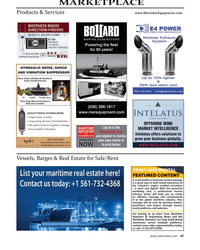 )
April 2024 - Maritime Reporter and Engineering News page: 47
)
April 2024 - Maritime Reporter and Engineering News page: 47on to the • Sizes available to 40 gallons MARKET INTELLIGENCE MarineLink.com Intelatus offers solutions to and register to receive grow your business globally. (877) 534-6445 your copy online or www.wilkesandmclean.com in print today! [email protected] WWW.INTELATUS.COM Vessels, Barges
-
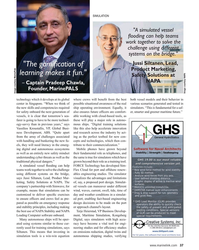 )
April 2024 - Maritime Reporter and Engineering News page: 37
)
April 2024 - Maritime Reporter and Engineering News page: 37made on the port and stability principles, including making or approach channel's layout. the best use of NAPA Stability and NAPA Terje Heierstad, VP Business Develop- Loading Computer software onboard. ment, Maritime Simulation, Kongsberg Many autonomous ships will be oper- Digital, says simulators with
-
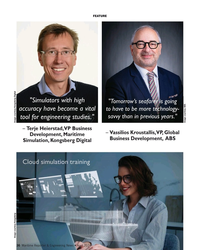 )
April 2024 - Maritime Reporter and Engineering News page: 36
)
April 2024 - Maritime Reporter and Engineering News page: 36become a vital to have to be more technology- savvy than in previous years." tool for engineering studies." Image courtesy ABS – Terje Heierstad, VP Business – Vassilios Kroustallis, VP, Global Development, Maritime Business Development, ABS Simulation, Kongsberg Digital Clou u u ud d d d d d d s si
-
 )
April 2024 - Maritime Reporter and Engineering News page: 25
)
April 2024 - Maritime Reporter and Engineering News page: 25engineer, but I can You not just commanding an operational ? eet, tell you that there are fewer and fewer mariners these days you’re running a global business enterprise. Correct. MSC has responsibilities and authorities that who know steam plants. I can say that we’re expending a lot span the entire Navy
-
 )
April 2024 - Maritime Reporter and Engineering News page: 21
)
April 2024 - Maritime Reporter and Engineering News page: 21– today it is not possible for ABS to put a de? nitive – became ‘mobile and global’, working with SBM in the ? oat- number on ‘how fast, how far’ this business will grow. “It is ing offshore world with FPSOs and the turret business, then dif? cult to provide quantitative ? gures as this is driven by the
-
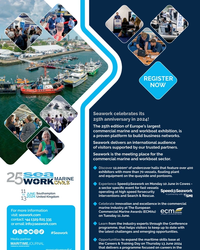 )
April 2024 - Maritime Reporter and Engineering News page: 7
)
April 2024 - Maritime Reporter and Engineering News page: 7its 25th anniversary in 2024! The 25th edition of Europe’s largest commercial marine and workboat exhibition, is a proven platform to build business networks. Seawork delivers an international audience of visitors supported by our trusted partners. Seawork is the meeting place for the commercial
-
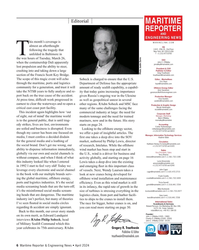 )
April 2024 - Maritime Reporter and Engineering News page: 6
)
April 2024 - Maritime Reporter and Engineering News page: 6. His story Accounting edy strikes, lives are lost, environments starts on page 24. Esther Rothenberger [email protected] are soiled and business is disrupted. Even Looking to the offshore energy sector, +1.212.477.6700 ext 6810 though my career has been one focused on we offer a pair of
-
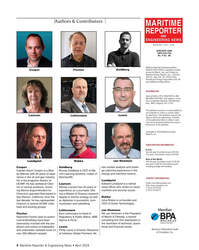 )
April 2024 - Maritime Reporter and Engineering News page: 4
)
April 2024 - Maritime Reporter and Engineering News page: 4in extensively involved with the pre- the resolution of technical, opera- diction and control of habitability Lewis tional and ? nancial issues. Business Publications Audit and underwater radiated noise on Philip Lewis is Director Research of Circulation, Inc. over 350 different vessels. at Intelatus
-
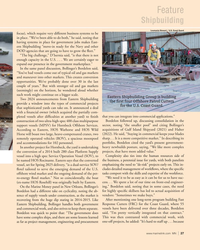 )
April 2024 - Marine News page: 27
)
April 2024 - Marine News page: 27Feature Shipbuilding Loumania Stewart / U.S. Coast Guard focus), which require very different business systems to be in place. “We’ve been able to do both,” he said, noting that having systems in place for government jobs makes East- ern Shipbuilding “move-in ready for the Navy and other DOD agencies
-
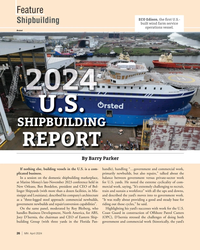 )
April 2024 - Marine News page: 26
)
April 2024 - Marine News page: 26REPORT By Barry Parker If nothing else, building vessels in the U.S. is a com- handle), handling “…government and commercial work, plicated business. primarily newbuilds, but also repairs,” talked about the In a session on the domestic shipbuilding marketplace, balance between government versus
-
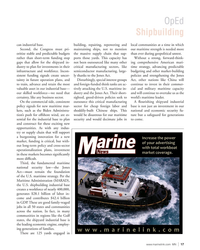 )
April 2024 - Marine News page: 17
)
April 2024 - Marine News page: 17maritime capacity our skilled workforce—we need that dustry and the Jones Act. Their short- and will continue to overtake us as the certainty, like any business sector. sighted, greed-driven policies seek to world’s maritime leader. On the commercial side, consistent outsource this critical manufacturing
-
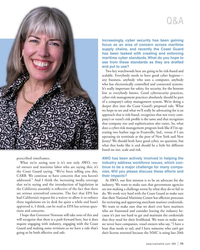 )
April 2024 - Marine News page: 11
)
April 2024 - Marine News page: 11as they are drafted and put to use? Two key watchwords here are going to be risk-based and scalable. Everybody needs to have good cyber hygiene— any business, anybody who uses a computer, anybody who has electronically controlled and connected systems. It’s really important for safety, for security, for
-
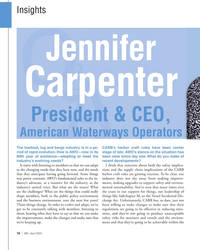 )
April 2024 - Marine News page: 10
)
April 2024 - Marine News page: 10for things, our leadership of shape members, both in the public policy environment things like Subchapter M, or the Vessel Incidental Dis- and the business environment, over the next few years? charge Act. Unfortunately, CARB has, to date, just not Those things change. In order to evolve and adapt,
-
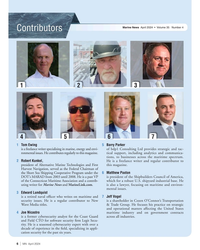 )
April 2024 - Marine News page: 6
)
April 2024 - Marine News page: 6Ltd provides strategic and tac- ronmental issues. He contributes regularly to this magazine. tical support, including analytics and communica- tions, to businesses across the maritime spectrum. 2 Robert Kunkel, He is a freelance writer and regular contributor to president of Alternative Marine Technologies
-
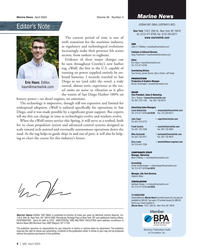 )
April 2024 - Marine News page: 4
)
April 2024 - Marine News page: 4Montauk Hwy. #867 Bayport, NY 11705 The publisher assumes no responsibility for any misprints or claims or actions taken by advertisers. The publisher Business Publications Audit reserves the right to refuse any advertising. Contents of the publication either in whole or part may not be produced of Circulation
-
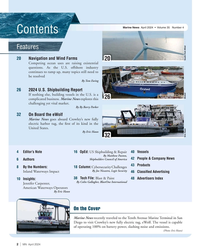 )
April 2024 - Marine News page: 2
)
April 2024 - Marine News page: 2topics still need to be resolved By Tom Ewing 26 2024 U.S. Shipbuilding Report If nothing else, building vessels in the U.S. is a 26 complicated business. Marine News explores this challenging yet vital market. By By Barry Parker 32 On Board the eWolf Marine News goes aboard Crowley’s new fully
-
 )
April 2024 - Marine News page: Cover
)
April 2024 - Marine News page: Cover35 • Number 4 arine APRIL 2024 www.marinelink.com News M eWolf First Fully Electric Tug in the U.S. 2024 Shipbuilding Report A Challenging & Complicated Business Offshore Wind Solving Marine Navigation Problems Inland Waterways An Economic Engin
-
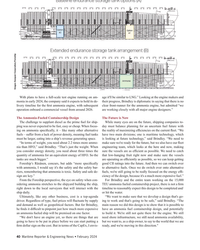 )
February 2024 - Maritime Reporter and Engineering News page: 40
)
February 2024 - Maritime Reporter and Engineering News page: 40that will interact with the timeline to reasonably expect this design to be completed and/ ship daily. or hit the water. Ultimately, like any other business, cost is a top-agenda “We want to make sure that we develop a design that's go- driver. Regardless of type, fuel prices will ? uctuate by supply
-
 )
February 2024 - Maritime Reporter and Engineering News page: 36
)
February 2024 - Maritime Reporter and Engineering News page: 36controllable pitch propeller PTO powertrain Source: MAN Energy Solutions how the system is intended to operate, says Oskar Levander, VP Strategy & Business Development, Kongsberg Maritime. For example, a primary shaft-driven PTO rotates whenever the engine is running; a secondary one whenever the propeller
-
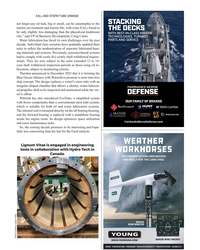 )
February 2024 - Maritime Reporter and Engineering News page: 33
)
February 2024 - Maritime Reporter and Engineering News page: 33life, with some EALs found to THE DECKS be only slightly less damaging than the phased-out traditional WITH BEST-IN-CLASS MARINE oils,” said VP of Business Development, Craig Carter. TECHNOLOGIES, TURNKEY PARTS AND SERVICE Water lubrication has faced its own challenges over the past decade. Individual
-
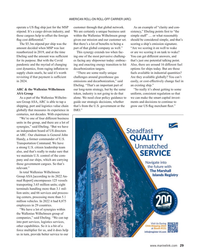 )
February 2024 - Maritime Reporter and Engineering News page: 29
)
February 2024 - Maritime Reporter and Engineering News page: 29the MSP customer through that global network. As an example of “clarity and con- stipend. It’s a cargo driven industry, and We are certainly a unique business unit sistency,” Ebeling points ? rst to “the those cargoes help to offset the foreign within the Wallenius Wilhelmsen group simple stuff” … or
-
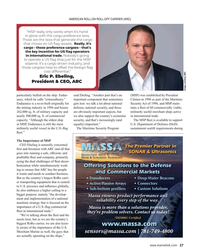 )
February 2024 - Maritime Reporter and Engineering News page: 27
)
February 2024 - Maritime Reporter and Engineering News page: 27eying the dual challenges of ? eet decar- bonization while simultaneously work- ing to ensure that ARC has the people it wants and needs to conduct business. But as the country’s largest RoRo carri- er transporting equipment that is central to U.S. presence and in? uence globally, he also embraces
